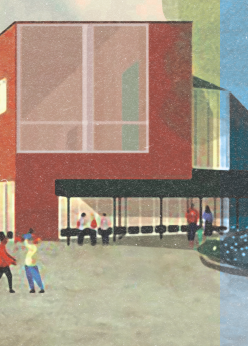
According to the school safety study, the Georgian model of “safe school” is predominantly based on control-oriented approaches. Surveillance cameras or metal detectors, together with security officers and an electronic database, provide an environment that is less compatible with modern progressive concepts of the “safe school”, which are focused on care and support.
The Social Justice Center, together with the non-governmental organization Bemoni, has drafted three documents aiming to enhance the capacity of the educational system and relevant personnel to combat criminal and violent behavior, as well as to develop and implement strategies for the prevention of abuse of psychoactive substances. The documents have been prepared in the framework of the CPR project supported by the European Union “Empowering civil society and professional organizations to ensure a safe, secure, and accountable society in Georgia”, which is implemented by the following organizations under the leadership of the Open Society Georgia Foundation:
Social Justice Center, Bemoni, Alternative Georgia, Family Medicine Association of Georgia, Step to the Future, and Xenon. One of the goals of this project is to strengthen the capacities of law enforcement authorities and the educational system in order to prevent, identify, and intervene in a timely manner and overcome criminal and violent behavior. In general, crime prevention functions are only perceived as part of the operation of the law enforcement system. The role of public authorities which are involved in health care, education, social, cultural, and youth policy is minimal in crime prevention policy.
The practice of using inclusive, inter-agency programs is scarce.
In contrast to existing frameworks, the appropriate modern model involves more progressive measures to prevent crime, including enlargement of the scope of criminal law and enhancement of the institutions responsible for the improvement of social conditions and welfare.
The first document – School Safety, an Analysis of Planning and Implementation of Safety Policy in General Education Institutions shows that current approaches to safety reinforced by legislation and policy still give advantage to control-oriented mechanisms. It is true that, compared to the initial years, the duty of care was added to the scope of the office of resource officers (mandatory), but there was no radical shift towards the policy of care in the school system overall. This is also caused by the fact that the resources of social workers and psychologists in general educational institutions are extremely scarce. It is important that in this regard, relevant agencies and the state as a whole work actively on the introduction of a new political point of view.
The second document – The School Policy on Psychoactive Substances and Safety is a document for intra-school use, adjusted to the individual needs of the school, which regulates the basic rules and principles of school safety planning and implementation of its safety policy.
The manual that was created by the organization Bemoni along with the Social Justice Center based on the research conducted, is already functional in the pilot mode in 15 schools of 6 regions. In the framework of training, resource officers of the school, representatives of the school directorate, board of trustees, board of pedagogues, parents, board of schoolchildren self-government, or disciplinary committee tend to take a genuine interest in the discussion of the situations and problems that these schools face on a daily basis.
The third document – Research of the Crime Prevention Policy responds to the stage when there is a conflict with the law, which we help to avoid with the school safety policy.
Based on the discussion of the existing challenges, the research provides recommendations and grounds for considering the ways of development of the prevention policy.